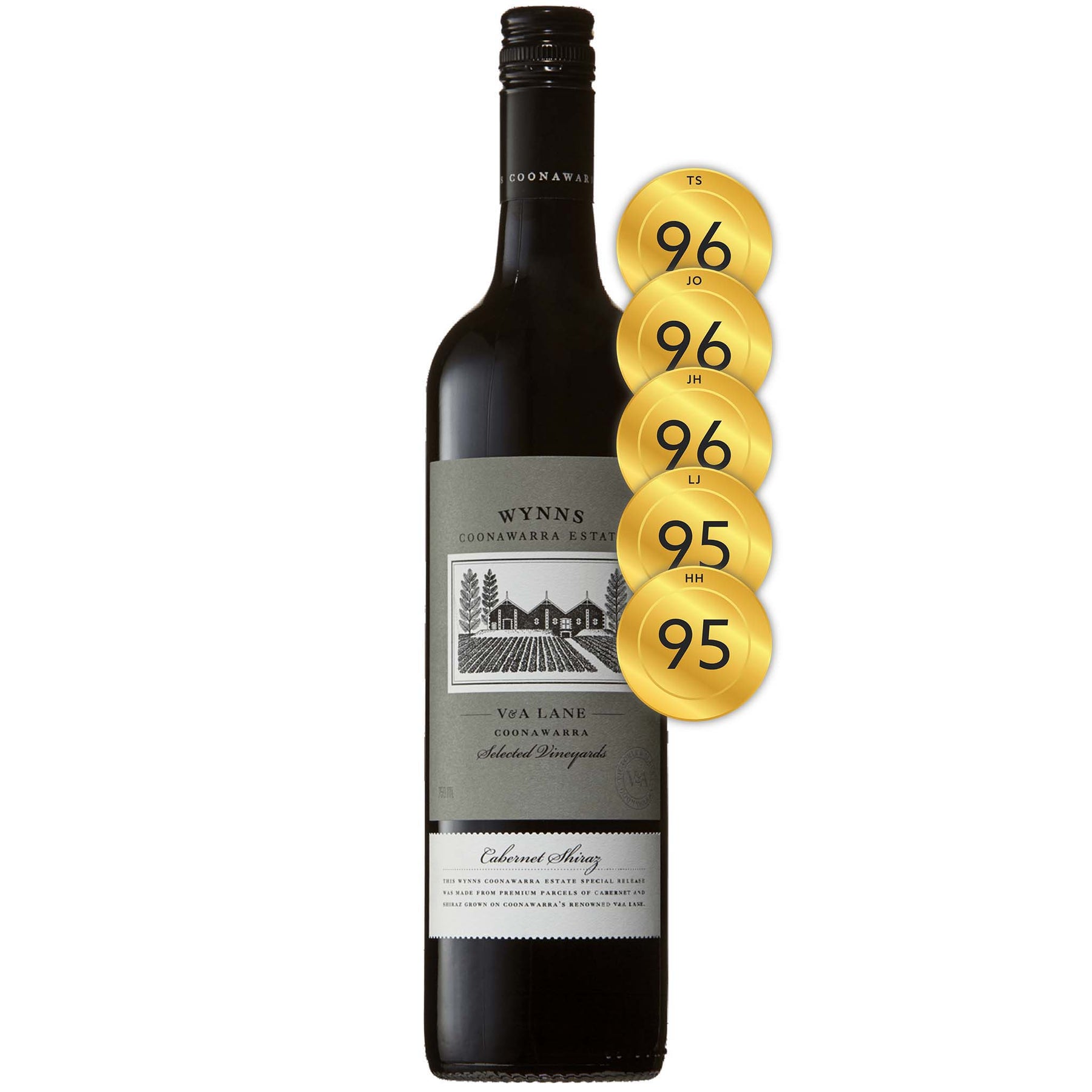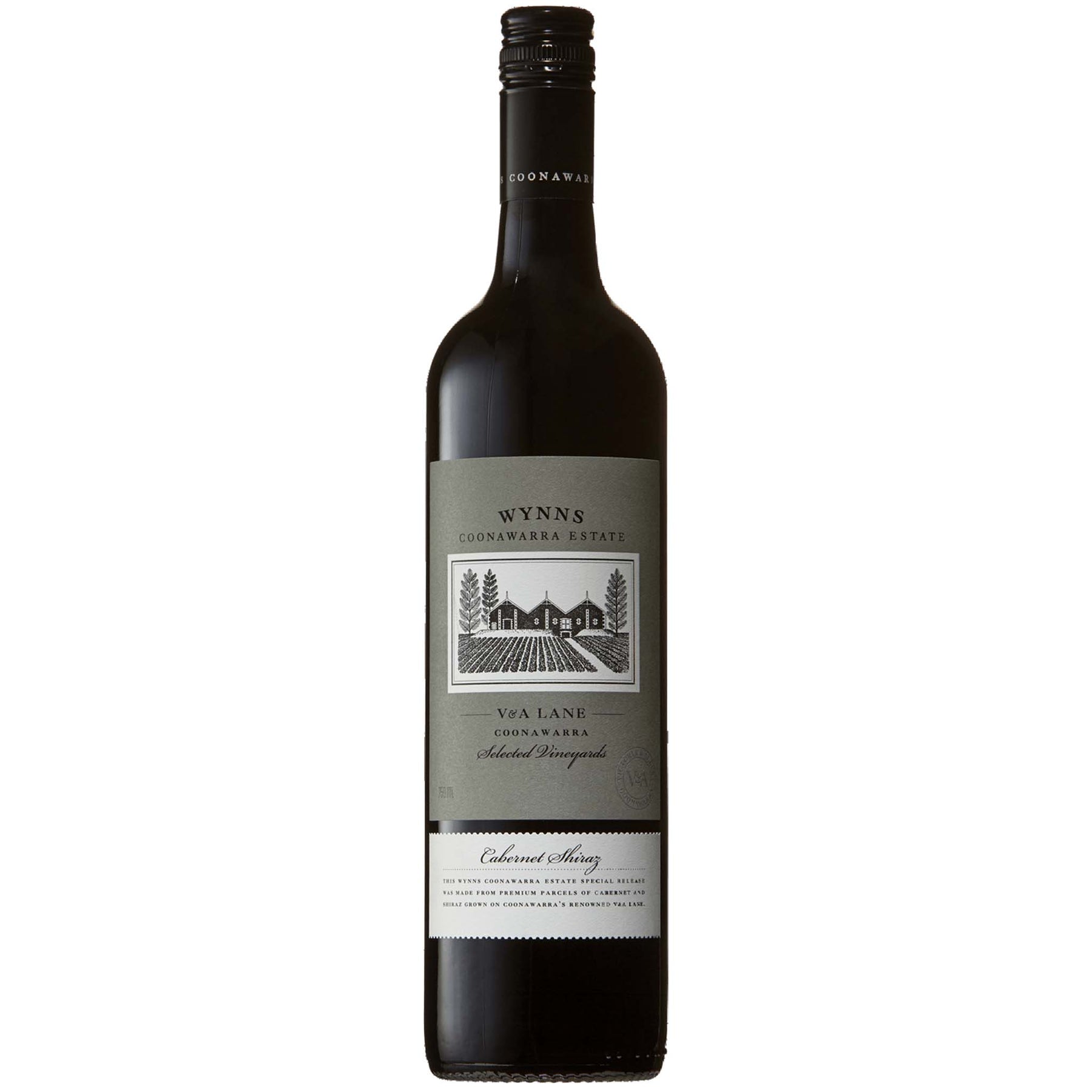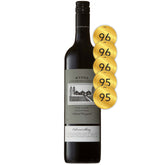

Wynns Coonawarra Estate V&A Lane Cabernet Shiraz 2012
Style: Red Wine
Variety: Cabernet Shiraz
Closure: Screwcap
Wynns Coonawarra Estate V&A Lane Cabernet Shiraz 2012
Warehouse
34 Redland Drive
Vermont VIC 3133
Australia
Critic Score: 96
Alcohol: 13.5%
Size: 750 ml
Drink by: 2042
"The V&A story is all about fineness, grace and beauty, but there is an underlying power, too." James Halliday
The Wynns V&A Lane Cabernet Shiraz honours Wynns' prized vineyards along the V&A Lane, a long, straight road dissecting Coonawarra's famous terra rossa strip at its midpoint. It is an area celebrated for exceptional cabernet sauvignon and shiraz wines. The Cabernet vineyards from V&A Lane have been important contributors to Wynns' top wines for many years.
In 2008 Wynns started making two V&A Lane wines, a Cabernet Shiraz and a Shiraz. The 2012 V&A Lane Cabernet Shiraz, from a sensational vintage, is the fourth release of the wine. The grapes for the Cabernet Shiraz are harvested on the same day and then co-fermented.
"Deep red/purple colour; the bouquet spicy and berry fruited, clean and fresh and vibrant. Lively and bright. A wonderfully tight, elegant, refined wine of tremendous length and precision. I will enjoy watching how this develops with time." Huon Hooke
Expert reviews
"A riper, more traditional Australian style augmented by finely honed oak and tannin. Bright and enticing, its spicy, peppery fragrance of fresh black and red berries, dark plums and cedary oak reveals a hint of dried herbs. It's full to medium bodied, with a pristine, almost fiery presence of dark berry flavour that knits tightly with faintly toasty cedar/vanilla oak, extending long and vibrant down a firm, gravelly spine towards a lingering and finely balanced finish. Drink 2032-2042." Jeremy Oliver - 96 points
"Limpid crimson-purple; a 67/33% blend, it has features that take me back to the Woodley Treasure Chest wines of the '40s and '50s - a certain austerity that comes in part from tannins, but more importantly, from the acidity of the fruit has at this alcohol level. Drink by: 2042." James Halliday, Halliday Wine Companion - 96 points
"Distinguished, coiled and driven, this is a blend of impeccable structure, fragrant finesse and enduring longevity. It's restrained, gently and alluringly floral, with rose hip notes and wonderful purity of blackcurrant and blackberry fruit and pepper of focused purity. Fine chalk mineral tannin texture is particularly pronounced in V&A Lane, a signature of this part of Coonawarra. 2012 represents the pinnacle of V&A Lane to date, testimony to fanatical, microscopic attention in the vineyard and small batch focus in the winery." Tyson Stelzer – 96 points
"Deep red/purple colour; the bouquet spicy and berry fruited, clean and fresh and vibrant. Lively and bright. A wonderfully tight, elegant, refined wine of tremendous length and precision. I will enjoy watching how this develops with time. Drink: 216 to 2044." Huon Hooke, The Real Review - 95 points
"A very fresh merging of both varietal characteristics. Lingering, fine, firm tannins. Impressive. Vibrant fruit. Again classic Coonawarra weight." Lester Jesberg, Winewise - Highly Recommended (94-96 points)
"A blend of 68% Cabernet Sauvignon and 32% Shiraz. The cooler year is signposted by a more elegant, spicier palate whose blackcurrant and juicy black plum fruit is threaded with vanillin, cedar and five spice notes; savoury black olive too. Youthfully wholesome and fresh; a long, persistent finish is well supported by a spine of firm powdery tannins. Lovely, classic expression. The 2012 vintage was aged for 15 months in a combination of new and seasoned French oak hogsheads and barrels. 13.5%." Sarah Ahmed, The Wine Detective
About V&A lane

"Wynnsday has been and gone for another year, but the wines will linger and give pleasure for decades, especially this year's vintage, the sensational 2012s.
Wynns Coonawarra Estate winemaker Sarah Pidgeon was doing the rounds last week, showing off the 2012 vintages of the two V&A Lane reds, shiraz and cabernet shiraz.
These are Sarah's playthings. She's not the chief winemaker (that's Sue Hodder), but with these wines Sarah gets to call the shots. The wines were created in the 2008 vintage so the '12s are the fourth release (they skipped 2011 for obvious reasons). According to Sarah, the two wines are sourced from a number of the company's own vineyards in the vicinity of V&A Lane. Although V&A Lane pretty much runs east-west through the centre of the terra rossa strip, it is the earliest ripening part of Coonawarra – earlier than the north, the south, and the lowest altitude parts of the region.
Hence, these vineyards are the first to be harvested each year. Sarah has styled the wines around the idea of earlier harvesting: they are always 13% alcohol and a very elegant, medium to full-bodied style with quite gentle structures. A small portion of the grapes are fermented as whole berries and/or whole bunches, which may result in slightly more lifted aromatics. She sees the wines as a little fresher, not necessarily lighter but with a different flavour spectrum. She baulks at defining what that spectrum is, seeming to prefer to leave that to the taster.
The wines are excellent, my preference being slightly towards the cabernet shiraz, which is a blend wavering between 60/40 and 70/30.
Wynns' viticulturalist Allen Jenkins has raised a few eyebrows with his vineyard mapping, which shows there is a significant difference in some of the Wynns vineyards with just two metres of altitude.
Now, it's nothing new to make fun of Coonawarra for being pancake-flat, but the proof is there for all to see. There's an observable difference in ripeness between parts of the vineyards which are 58 metres above sea level compared with 60 metres. Just two metres can be significant. The same grape variety, managed the same way, ripens earlier on the higher parts. That's because in the higher parts, the soil is more weathered, better drained and redder in colour.
In many wine regions, you might expect lower-lying spots to be warmer, and in a cool climate that's a positive for ripeness. Not in Coonawarra. Lower-lying, even just two metres lower, can mean poorer ripeness, and the reason is suspected to be that cold air pools in these places. Cold air drains and settles, rather like water does. It sounds unlikely, but the evidence is there.
And it helps explain why the V&A Lane area ripens first. It's the highest.
As Sarah Pidgeon says, Coonawarra's strengths are cabernet sauvignon and shiraz: rather than grow other grapes badly and make ordinary wine, Wynns is interested in doing different things with the varieties that excel in the region. V&A Lane is one of the many permutations." Huon Hooke, The Real Review (Aug 2014)
Sue Hodder

Sue Hodder is one of Australia's best-known winemakers. Sue grew up in Alice Springs and began her wine career as a viticulturist before moving into winemaking. She joined Wynns in 1993 as a winemaker under the guidance of Peter Douglas before being appointed senior winemaker in 1998.
Sue celebrated her 30th vintage at Wynn's in May 2022 in the same year that the winery celebrated 40 years of the winery's John Riddoch Cabernet Sauvignon, named after the pioneer who first plated the vineyards back in 1891.
After 30 vintages, Hodder said: "I still have great joy in walking out the back door to our historic triple-gabled winery. While this beautiful building remains largely untouched, we do now use smaller tanks, oak fermenters, different oak barrels, and an optical berry sorter. These winemaking tools just enable us to be more confidently creative. Our winemaking team has had remarkably few changes over the years – we are a family at Wynns, and our house style remains clear.”
Sue Hodder has been the guiding light for Wynns since the nineties, supported by viticultural guru Allen Jenkins and winemaker Sarah Pidgeon. Over the last 20 years the team have overseen a program of revitalizing and replacing the old vines damaged by excessive machine pruning. Since 2002, 300 hectares of vines have been rejuvenated. They have also purchased the best winemaking equipment available, including an optical grape sorter that had "shocking" results, according to Hodder. "The main result is brighter fruit," she says.
In addition, Sue has initiated a move to open fermentors in the winery and 100% French oak, which together with the viticultural improvements, have resulted in more elegant wines with greater fruit purity and very bright, precise fruit flavours and aromas.
Sue and Allen were joint winners of the 2010 Gourmet Traveller WINE Winemaker of the Year Award, among many other accolades Sue has picked up in her esteemed career. In 2021 Sue became a Fellow of the Australian Society of Viticulture and Oenology (ASVO) for her outstanding and meritorious contribution to Australian wine
About the winery

What is now Wynns Coonawarra Estate was founded by Scottish pioneer John Riddoch. He planted vineyards in 1891 and built the famous three-gabled winery. By 1897, 89 hectares of vines had been cultivated. After a promising start, the Coonawarra Fruit Colony (as it was called then) failed to prosper due to its distance from major markets and poor economic conditions. John Riddoch died in 1901 at the age of 73.
In 1951, Melbourne wine merchants Samuel Wynn and his son David purchased Riddoch's original vineyards and winery and renamed the property Wynns Coonawarra Estate. The Wynns family recognised the intrinsic qualities of Coonawarra wines – their richness and intensity of fruit character – and set out to build an independent identity in the region. David took over the winery operations in 1953, and commissioned Melbourne artist Richard Beck to produce a woodcut of the winery facade. This illustration has appeared on every Wynns Coonawarra Estate label since, making it one of Australia's most recognised wine symbols.
Michael Shiraz (then called Hermitage) was a one-off from the 1955 vintage. The outstanding quality of the shiraz in one particular 2,300 litre vat was recognised for its quality, and bottled separately as Michael, named after David's first son. The second release of Michael Shiraz followed many years later in 1990.
Wynns increased its holdings in Coonawarra over the next two decades. By 1981, it was the largest grower in the district with 440 hectares under vine. The first wine bearing John Riddoch's name, the Wynns John Riddoch Cabernet, was produced in 1982.
David Wynn sold Wynns in the early seventies to focus on the Mountadam Venture with his son Adam. Over the last 50 years, Wynns has had many owners and in the new millennium, the company ended up in the vast portfolio of Treasury Wine Estates.
Today, Wynns Coonawarra Estate has 500 hectares of vineyards in Coonawarra and is the region's preeminent wine producer and largest single vineyard holder with the best and longest established vineyard sites in Coonawarra. Its wines are regarded as benchmarks for the district, lauded for their consistent quality, and depth of flavour.

South Australia
South Australian is responsible for more than half the production of all Australian wine. It is home to more than 900 wineries across 18 wine regions. The regions are Adelaide Hills, Adelaide Plains, Barossa Valley, Clare Valley, Coonawarra, Currency Creek, Eden Valley, Kangaroo Island, Langhorne Creek, McLaren Vale, Mount Benson, Mount Gambier, Padthaway, Riverland, Robe, Southern Fleurieu, Southern Flinders Ranges and Wrattonbully.
Many of the well-known names in the South Australian wine industry established their first vineyards in the late 1830s and early 1840s. The first vines in McLaren Vale were planted at Reynella in 1839 and Penfold's established Magill Estate on the outskirts of Adelaide in 1844.
South Australia has a vast diversity in geography and climate which allows the State to be able to produce a range of grape varieties - from cool climate Riesling in the Clare and Eden Vallies to the big, full bodied Shiraz wines of the Barossa Valley and McLaren Vale. Two of Australia's best-known wines, Penfolds Grange and Henschke Hill of Grace, are produced here. There is much to discover in South Australia for the wine lover.

